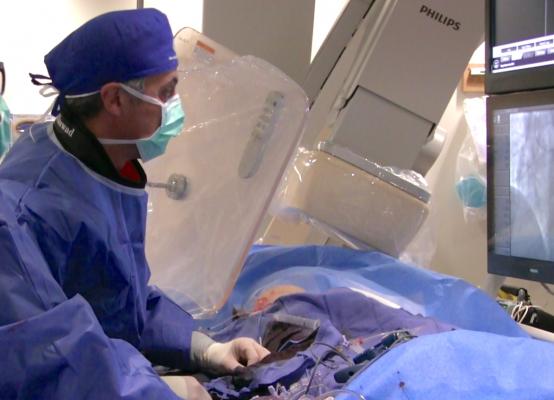
For a cardiovascular service line leader, addressing challenges in an evolving healthcare climate is a constant. Understanding the dynamics that influence the service line can arm the leader with information necessary to make timely, informed decisions – particularly the impact of continued migration to the outpatient setting. When the 2019 CMS reimbursement strategy for cardiovascular procedures approved additional cardiovascular procedures for ambulatory surgery centers (ASC), it made collaboration between administrators and physicians imperative to maintain market share and achieve specific cardiovascular service line strategic goals. The lower cost, highly efficient and convenient ACS environment is an ideal location for cardiovascular procedures, but requires a change in strategy for the ambulatory market.
Value within cardiovascular care is defined by the quadruple aim – improved patient experience, better health outcomes, lower cost of care and improved staff experience – and ASCs certainly support these initiatives. Today, The Healthcare Advisory Board predicts a 27.6 percent increase in ASC volume by 2027, and projections show nearly 50 percent of all cardiovascular procedures will be completed in an ASC by the mid 2020s.[1] This growth prompts some valid questions. How do cardiovascular service line leaders successfully embrace this change? And what are the key considerations for success?
The Financial Case for Ambulatory Surgery Centers (ASCs)
With the continued shift from volume to quality-based payments, those who remain in the hospital setting are caught in the middle of an ever-changing strategy to maintain their margins. As hospital margins are affected by the pressure of CMS penalties, depressed revenue growth and increased patient complexity, alternative revenue streams from an ASC may provide some relief.
The ASC benefits from reduced CMS administrative burden, as well as throughput and efficiency gains that impact capacity throughout the enterprise, can have a significant impact on margins in a well-run ASC. While there are several key profit drivers in both the hospital and ASC environment, such as the ratio of Medicare and Medicaid patients compared with private insurers and the favorability of negotiated insurance contracts, the ASC advantage comes in the flexibility of staffing models that can be employed and in efficiency advantages.
In addition, payers are decreasing Hospital Outpatient Department (HOPD) payments versus ASC payments to further support ASC utilization. It has been estimated that moving 5 percent of coronary interventions to an outpatient setting would save close to $20 million in Medicare payments and nearly $5 million in copays for beneficiaries.[2] As the push to the outpatient setting continues, payer provided contracts may now require pre-authorizations for HOPD, while PCPs can refer directly to ASCs.
How ASCs Benefit Both Patients and Providers
As consumers of healthcare, patients want ease of access, lower cost and timely care. ASC procedures typically have lower co-pays versus a HOPD. For example, a colonoscopy co-pay may be $185 in an HOPD but only $76 in an ASC. The efficiencies of an ASC also produce shorter wait times for the patients, as well as ease of scheduling and ease of facility access. More affordable costs combined with an attentive clinical staff make this a strong patient-centric experience.[3]
ASC physicians have the ability to gain control of their daily practices. The ease of scheduling, the focused clinical staff and the improved productivity make ASCs an ideal setting for the continued out- migration trend. Greater than 90 percent of ASCs are now physician equity owned, and productivity standards show an average of 31.8 minutes saved per procedure in an ASC versus an HOPD.[3] Consequently, accommodating the lower risk procedures in the ASC will allow appropriate scheduling of more complex cases in the interventional suites of an inpatient setting.
Implementing ASCs Into Your Cardiovascular Care Strategy
The most important first step in the transformation of CV procedures to the ASC is: Be ready. In some states the migration of cardiac procedures will be slower than others due to a number of factors. Payer differences, interest of physicians, governance standards and clinical factors can impact this transformation. Important questions to ask are: Is there opportunity to align with physicians who are not currently in the healthcare system, who may attract new patients? Is there opportunity to expand the geographic targets of the service line?
Key considerations for a move to the ASC model include:
• Focus on operational efficiency: While this is important regardless of the healthcare setting, maintaining profit margins in the ASC setting is especially critical. Since 2009, for every two ASCs that have opened one has closed. What is the level of support needed to be successful? Understanding physician scheduling, inventory management and performance metrics, along with skillful contract negotiation for in-network contracts, will support appropriate revenue growth.[4]
• Stay true to your mission and values: Does partnering with an ASC support your organization’s mission and vision? Or, if you are partnered with an ASC already, does expansion into cardiovascular care in this space align with your mission and vision? Careful review of your strategic initiatives with ASC partnership is needed to ensure you maintain or enhance your value proposition.
• Consider what services are offered: Tap into insights from your interventional providers to help scope the services that you intend to provide. It’s important to not only define what services the ASC will offer, but gain a solid understanding of what kind of volume to expect with each service. Providing cardiovascular care is not inexpensive, and while it is a revenue source, there are also many expenses associated with offering it.
• Be mindful of the impact of state legislature: Your state's laws will also play a role in an organization's ability to expand into the cardiovascular care market and will influence your time to market. There are still nine states that prohibit percutaneous coronary intervention in the ASC setting. Several others will require a Certificate of Need (CON) to participate in this arena.
• Conduct a financial analysis: A careful evaluation of case-mix and payor negotiated contracts is a must, as well as understanding the expected volume across procedure types and how they will affect the margin. ASC volume is critical to success due to the high cost of overhead in cardiovascular care. Coupled with the needed technology, the consumables in this area are equally costly. While potential revenue can be favorable, too many loss leaders will exert downward pressure on the entire service line.
The continued growth of ambulatory surgery centers for cardiovascular procedures cannot be ignored. Development of a comprehensive ambulatory market strategic plan will successfully guide this journey within cardiovascular services. Being a proactive leader in understanding this market dynamic will properly position the service line for the future.
Read the related article SCAI Issues Position Statement on PCI Performance in Ambulatory Surgical Centers.
About the Authors:
Deb Thompson, MBA, BSN, RN, is senior consulting manager, cardiology, at Philips Healthcare. She has over 25 years of cardiology nursing and leadership experience. She provides performance improvement strategies with hands-on process change support for interventional as well as noninvasive cardiology in the acute care and outpatient settings.
Christian Comeau, MBA, R.T. (R)(VI)(CI), is senior consulting manager, cardiology at Philips Healthcare. He has over 18 years of hospital leadership expertise across academic and community medical centers. Chris has strong experience as a process improvement practitioner and is Lean Six Sigma Black Belt certified. He holds certifications beyond radiology in vascular and cardiovascular intervention.
References:
1. Ambulatory Surgery Center Association. https://www.ascassociation.org/home
2. Marc Toth, Derek Mitzel. Coronary Interventions in the ASC: Now What? Does Your Health System Have an Ambulatory Strategy?. Cath Lab Digest. Volume 28, Issue 2, February 2020.
3. Stuart Clark. How to Win the Race for Ambulatory Market Share. 3 Steps to Build a Winning ASC Strategy. Healthcare Advisory Board. June, 2019.
4. Michelle Luffey. Evolution of Care Within the Ambulatory Surgery Center. Cath Lab Digest. Volume 28, Issue 2, February 2020.
5. Julie Bass. 3 Things to Know about CV Ambulatory Changes for 2020. Healthcare Advisory Board. Dec. 3, 2019. https://www.advisory.com/research/cardiovascular-roundtable/cardiovascular-rounds/2019/12/pci-ascs-policy-change-cv-program.


 April 09, 2024
April 09, 2024 








